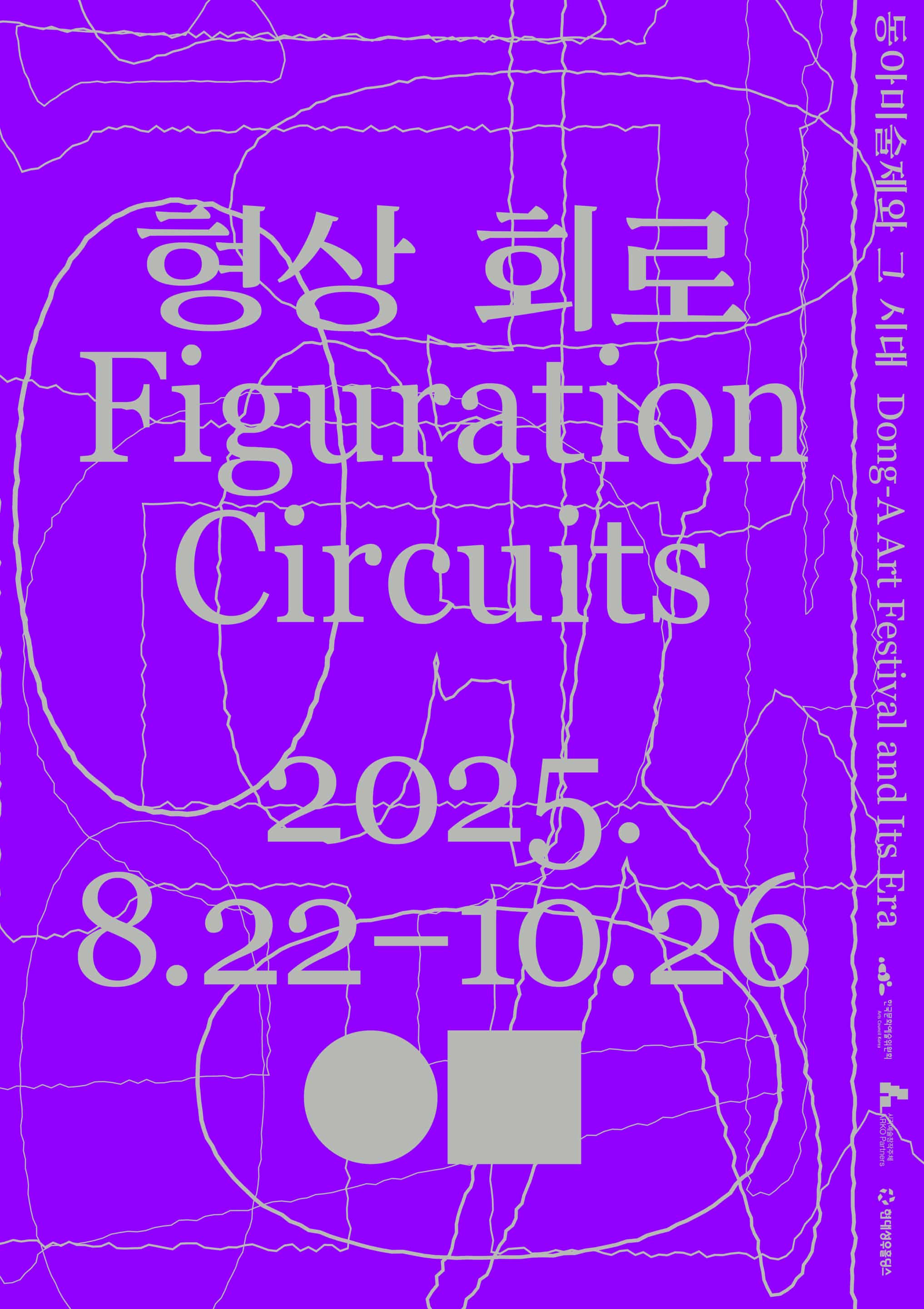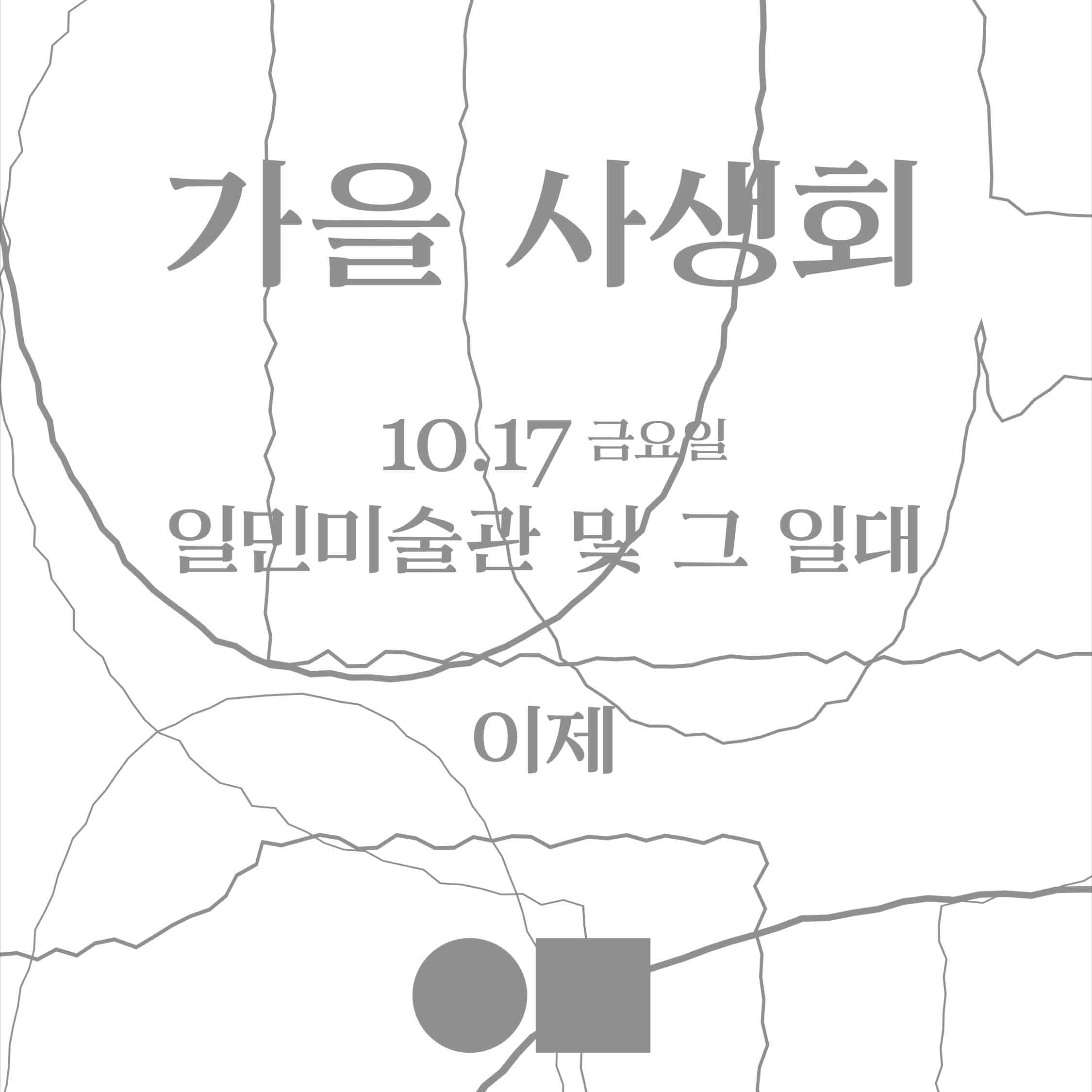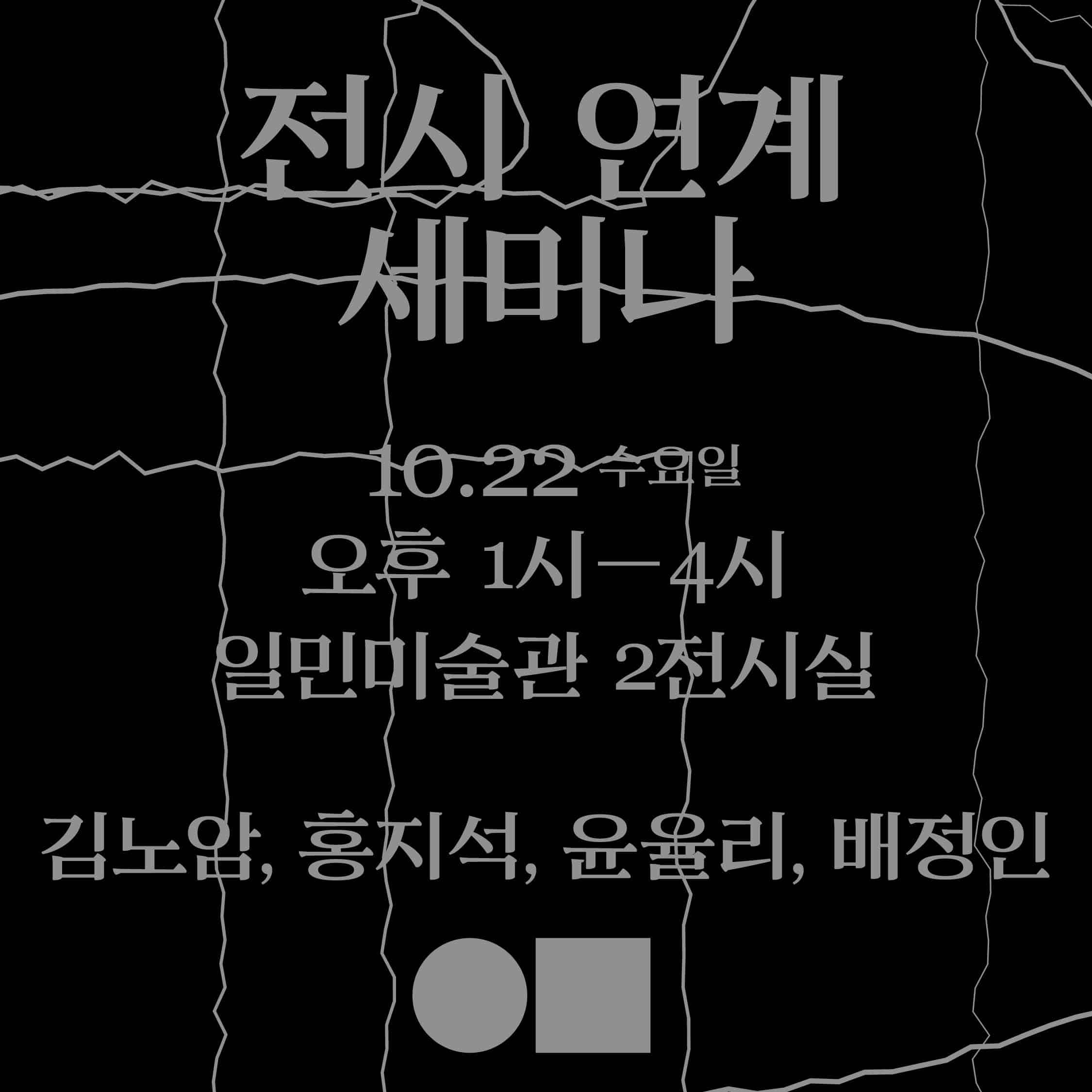누구나 이미지를 통해 현실을 본다. 보이는 현실을 변형하거나 조합한 심상을 의미하던 이미지가 이제 현실보다 먼저 도달해 우리가 보게 될 세계를 설계한다. 즉 현실의 결과로 이미지를 채택하는 것이 아니라 이미지의 결과로 현실을 받아들이는 일이 자연스러워졌다. 동시대 미술 역시 다양한 이미지를 자신의 원천으로 삼는다. 그런데 미술이 이미지로부터 태어나 이미지로 종결된다면 작가와 작품은 어떻게 현실에 닿을 것인가? 포스트모던 시대의 미술이 끝없이 복제되는 기호의 연쇄에서 재현의 종결을 입증했다면, 오늘날의 미술은 실재하는 것의 환영이 아니라 이미지의 그림자와 투쟁한다. 이런 시대의 미술에서 재현은 기피하거나 끊어내야 할 사슬이 아니라 오히려 세계를 딛기 위해 회복해야 할 연결고리처럼 보인다. 이것이 지금 형상의 문제가 다시 제기되는 이유다.
《형상 회로: 동아미술제와 그 시대》(이하 형상 회로)는 《동아미술제》(1978)를 계기로 한국 미술의 현대적 도약이 펼쳐진 형상의 시대를 조망하는 전시다. 1970년대는 단색화가 이룬 성취가 정점에 도달함과 동시에 주류화된 형식주의 내부에서 현실을 향한 새로운 감각이 싹튼 시기다. 제도적으로는 국가가 미적 판단을 독점한 ‘국전’—대한민국미술전람회(1949—1981, 문교부 주최)—의 관제 미학을 거부하고 그 경직성을 타파하려는 요구가 분출했다. 1978년 동아일보사와 동아방송이 개최한 동아미술제는 ‘새로운 형상성’을 화두로 미술이 세계와 관계 맺는 방식을 일신하려 했다.
여기서 주목할 것은 ‘형상’이라는 용어의 사용이다. 이전까지 미술의 관례에서 ‘구상(具象)’은 주로 사실주의적 화법을 지칭하는 말로 좁게 쓰였으나, 형상은 이러한 틀에서 벗어나 사실 재현과 순수 추상 어디에도 속하지 않는 미학적 활로를 찾기 위한 의지를 반영한다. 동아미술제는 회화와 조각 부문으로 나뉘었는데 각 부문 수상작은 매체의 고유성을 강조하기보다 미술제의 취지에 맞추어 기존 형식을 뛰어 넘으려는 시도를 보였다. 1980년대 형상 탐구는 일군의 실험미술이 거둔 성과와 함께 탈매체, 다원주의, 일상에 관한 관심과 유희로 수용되며, 1990년대 본격적으로 전개된 한국 포스트모더니즘 미술의 토대를 이룬다.
다음은 형상의 논의가 담으려 했던 사회적 변화와 의지이다. 1970년대 후반 한국은 압축적 근대와 유신체제라는 전무후무한 개발 시스템의 격랑을 통과했다. 규격화된 아파트 단지가 삶의 터전이 된 도시에서 개인성의 발견은 익명의 집단 내부에서 각성한 감각적 현실과 연동되었다. 비로소 사적이고 구체적인 삶의 질감이 개인의 정체성을 구성하는 미학적 단위로 떠오른 것이다. 여전히 ‘우리’의 이념이 삶을 규율하는 가운데 낡은 골목길의 벽돌 건물, 버스 손잡이의 차가운 감촉, 텔레비전과 수입 공산품이 침범하는 미시적 풍경이 강렬한 대비를 초래했다. 이와 같은 물질의 범람은 굴절된 모더니즘이나 세상을 초월한 구도(求道)의 미술이 목격하거나 기록할 수 없는 것으로, 동아미술제를 통해 전면에 부상한 형상의 추구는 이에 호응하는 가장 정직한 응답이었다. 동아일보사를 비롯해 중앙일보사(중앙미술대전), 한국일보사(한국미술대상전) 등 언론사가 이른바 ‘민전’을 주도한 점은 흥미롭다. 변화한 세계의 현실성을 투영하길 바란 ‘미디어’의 사명이 미술의 사명과 일치한 것이다.
마지막으로 형상의 시대와 기원을 공유하는 구상성의 복권이다. 이 움직임은 신표현, 신구상, 자유구상 같은 표제와 함께 미술의 보편적인 흐름으로 전개됐다. 예컨대 이때 ‘새로운 표현성’이란 위계 없이 뒤섞인 대상 혹은 세계를 대면하면서 인식과 표현의 기술적 일치를 시도한 노력으로 요약할 수 있다. 한국 미술에서는 1980년대 이후 ‘리얼함’을 추구하는 소수의 실천이 꾸준히 지속되었고, 특히 2000년대부터 사진이나 스크린 이미지를 재구성하거나 내면의 심리와 동시대의 풍경을 적극적으로 통합하는 회화적 양식이 가시화되었다. 일민미술관의 지난 전시 《히스테리아: 동시대 리얼리즘 회화》(2023)는 산발적으로 잔존한 구상의 실천을 계보화함으로써 이것이 미술사에서 갖는 의의를 탐색했다. 《형상 회로》는 이 기획의 막후에 존재하는 다른 이야기를 비춘다. 이번 전시가 소개하는 동아미술제 수상작가—변종곤, 이승택, 박장년, 한운성, 곽정명—와 인근의 작가—게오르그 바젤리츠, 마르쿠스 뤼페르츠, 정강자—, ‘그 시대’의 지형을 이루는 작가—공성훈, 정석희, 이제, 박광수, 호상근, 김세은, 심현빈, 나디아 지와, 김현진—들로부터 일련의 경향을 찾는다.
《형상 회로》는 형상에 관한 넓은 범주 중 일정한 부분을 다룬다. 우선 정형화된 극사실주의의 이해를 따르지 않는다. 극사실화는 초기 형상 논의의 발전에서 중요한 양식이 되었으나, 본 전시가 진단하는 구상의 흐름은 사실적 경향을 받아들여 일부 작가가 도달하려 한 현전성에 초점을 맞춘다. 다음으로 1980년대에 민중미술에 가까워진 형상미술을 전시의 맥락과 구분한다. 형상과 민중의 접점은 비교적 풍부하게 해명된 영역으로, 이 담론은 이미 포스트민중에 이르기까지 현대적 구상을 읽는 주류의 비평 언어로서 성과와 한계를 모두 남겼다. 전시는 이에 속하지 않은 미학적 도약으로서의 형상에 주목한다. 《형상 회로》의 형상들이 감각의 역전이나 충격, 변화한 미디어 환경에 대한 반응으로 추동되었듯, 최근 미술에서는 재현이나 환영의 타파가 아니라 광의의 리얼리즘에 근간해 현상적 경험을 매개하려는 경향이 감지된다. 형상적 충동이 지속되는 이유는 무겁고 느린 이미지를 생산하는 능력이야말로 현실에 돌아 앉아 등을 맞댈 수 있는 미술의 독자성이기 때문이다. 이것은 “직접 충격을 줄 수 있는 현실과 사실을 찾는” 한편, “현실을 상기시킬 수 있는 대상이 아닌 현실 자체”를 제시하려 한 동아미술제의 목표와 여전히 부합한다. ‘형상 회로’는 이처럼 일순간 현실과 이어져 불을 밝히는 미술의 작용인 동시에, 각자의 거리와 시차를 가진 회로 내부에서 빛을 발하는 작가적 실천을 의미한다.
기간
2025.8.22.(금)―10.26.(일)
장소
일민미술관 1, 2, 3전시실 및 프로젝트 룸
주최
일민미술관
후원
한국문화예술위원회, 현대성우홀딩스
참여작가
공성훈, 곽정명, 김세은, 김현진, 마르쿠스 뤼페르츠, 게오르그 바젤리츠, 박광수, 박장년, 변종곤, 심현빈, 이승택, 이제, 정강자, 정석희, 나디아 지와, 한운성, 호상근
관장
김태령
책임기획
윤율리
기획
윤지현
진행
배정인
학예실
최혜인, 백지수, 신지현, 이지언, 정연지, 이채린, 김의경
행정 및 관리
최유진, 박서영, 유아영, 이성호
그래픽 디자인
프론트도어
공간조성
석운동
설치
현대 ADP
번역 및 영문 감수
김지선, 일민미술관 학예실
도움
대구미술관, 아라리오뮤지엄, 갤러리현대, 아라리오갤러리, 타데우스 로팍, ROH
관람시간
화―일요일 오전 11시―오후 7시,
월요일 휴관
관람료
일반 9,000원, 학생 7,000원(만 24세 이하 학생증 소지자)
도슨트 프로그램
일요일 오후 3시, 40분 소요, 현장참여
서울시 종로구 세종대로 152
주차공간이 협소하니 대중교통을 이용해 주시기 바랍니다.(동아미디어센터 주차 시 10분당 1,000원)
문의 02–2020–2050 / info@ilmin.org
Everyone sees reality through images. Once defined as mental representations that reframed or reassembled visible reality, images now arrive before reality itself, shaping the world we come to see. In other words, we no longer accept the image as an outcome of the real but as a precondition that defines the real. Contemporary art, too, draws from this expanded field of images. But if art both originates from and culminates in image, how then do artists and artworks engage with the real? Whereas postmodernism exposed the end of representation through its endless production of signs, art today wrestles not with the image as an illusion of the real but as a phenomenon in its own right. In such an era, representation is not a chain to be avoided or severed, but a link to be restored in order to stand firmly upon the world. This is why the question of figuration is being posed once again today.
Figuration Circuits: Dong-A Art Festival and Its Era (hereafter Figuration Circuits) is an exhibition that examines the era of figuration as a pivotal moment in the modern trajectory of Korean art. The 1970s marked both the apex of Dansaekhwa and the emergence of a new sensibility toward reality within the dominant formalist paradigm. Institutionally, artists began challenging the rigid state-controlled aesthetics of the annual National Art Exhibition (the “Gukjeon” hosted by the Ministry of Education, 1949―1981), which had long dictated the terms of artistic legitimacy. It was within this ferment that Dong-A Ilbo Newspaper and Dong-A Broadcasting launched Dong-A Art Festival in 1978 and proposed “New Figuration” as a way to reimagine how art might engage with the world.
What is particularly notable here is the term “figuration.” While the Korean art world had long used the expression “representation (gusang)” to narrowly refer to a realistic style of depiction, “figuration (hyungsang)” suggested a departure from this framework and gestured toward an aesthetic pathway that was neither mimetic representation nor pure abstraction. While the festival featured two different categories of painting and sculpture, the awardees of each category often resisted medium-specific conventions, instead showcasing formal experimentation that reflected the event’s ethos. In the 1980s, the pursuit of figuration was taken up alongside the achievements of a group of experimental artists, framed by growing interest in dematerialization, pluralism, and playful engagements with everyday life. In the 1990s, it laid the groundwork for the rise of Korean postmodernism.
The figuration discourse also mirrored societal transformations in Korean life. By the late 1970s, South Korea was navigating the turbulence of unprecedented “development projects” marked by compressed modernization and the authoritarian Yushin regime. In cities dominated by standardized apartment blocks, the discovery of individuality came through a sharpened sensory awareness of reality within an otherwise anonoymous world. That is, the intimate, micro-level details of everyday life became the aesthetic building blocks of individuality and identity. While community ideology continued to govern daily life, the quotidian minutiae—brick buildings in old alleyways, the cold grip of a bus handle, the television, and imported consumer goods—drew a stark contrast with such rigidity. This proliferation of material culture could not be adequately accounted for or represented by Korea’s compromised modernism or world-bending abstraction. In this regard, figuration, as it emerged through Dong-A Art Festival, was the most straightforward resolution to this problem. Notably, around this time, Korea saw a rise in Minjeon (non-government juried exhibitions) organized by media outlets, such as JoongAng Ilbo (JoongAng Fine Arts Prize) and Hankook Ilbo (The Korean Art Grand Award Exhibition). That is, the media’s mission to reflect the reality of a transformed world converged with art’s own ambitions.
Moreover, the era of figuration shared origins with a resurgence of representational art, which evolved into movements such as Neo-Expressionism, New Figuration, and Free Figuration. The “new expressivity” of this period sought to view the world as a mixture of non-hierarchical subjects to achieve a technical unity between perception and expression. From the 1980s onward, a small group of artists persistently pursued this “realness,” and by the 2000s, a style of painting emerged that recomposed photographic and screen-based imagery or fused psychological interiority with contemporary landscape. In the spring of 2023, Ilmin Museum of Art presented Hysteria: Contemporary Realism Painting (2023), mapping the genealogy of these scattered practices of figuration and highlighting their art historical significance. Figuration Circuits, in turn, foregrounds an alternative, less-examined lineage. Featuring awardees of Dong-A Art Festival—Byun Chong Gon, Lee Seung-taek, Park Jang Nyun, Han Unsung, Kwack Jung-myung—as well as their contemporaries—Georg Baselitz, Markus Lüpertz, Jung Kangja—and later artists who shaped the artistic terrain of “that era,”—Kong Sung Hun, Jung Seokhee, Leeje, Park Gwangsoo, Ho Sangun, Kim Seeun, Shim Hyeonbeen, Nadya Jiwa, Kim Hyunjin—the exhibition identifies a series of interwoven trajectories.
Figuration Circuits addresses only a portion of the broad discourse of figuration. First, it departs from the established understandings of hyperrealism. While hyperrealism played a key role in early discussions of figuration, this exhibition focuses on the realist tendencies and artists who sought the sense of presence rather than precision. Second, it distinguishes figuration from its latter iteration that intersected with 1980s Minjung art. That intersection has been extensively studied, and the resulting discourse—extending into post-Minjung theory—has left both achievements and limitations as a dominant critical language for interpreting contemporary figuration. This exhibition seeks to illuminate figuration as an aesthetic endeavor that emerged outside of this framework.
The figurative forms presented in this exhibition often arise from a sense of shock, a certain inversion of senses, or from reactions to a shifting media environment. Similarly, contemporary art today appears less concerned with dismantling representation as illusion than with mediating phenomenological experience based on an expanded concept of realism. The impulse toward figuration endures today because the capacity to produce images of such gravity and slowness remains art’s distinct way of pressing up against reality. This aspect of art resonates with the original ambition of Dong-A Art Festival to “seek out a reality and truth capable of exerting a direct impact,” and to present “reality itself, rather than something that merely references it.” In this sense, “figuration circuits” refer both to the way that art gains power by connecting with reality and to the artistic practices that shine within a complex network of disparate spaces and timelines.
Period
2025.8.22.(Fri)―10.26.(Sun)
Venue
Ilmin Museum of Art (Exhibition Hall 1, 2, 3 and Project Room)
Organized by
Ilmin Museum of Art
Sponsored by
Arts Council Korea, Hyundai Sungwoo Holdings
Artists
Kong Sung Hun, Kwack Jung-myung, Kim Seeun, Kim Hyunjin, Markus Lüpertz, Georg Baselitz, Park Gwangsoo, Park Jang Nyun, Byun Chong Gon, Shim Hyeonbeen, Lee Seung-taek, Leeje, Jung Kangja, Jung Seokhee, Nadya Jiwa, Han Unsung, Ho Sangun
Director
Kim Taeryung
Chief Curator
Yoon Yuli
Curator
Yoon Jihyun
Coordinator
Bae Jeongin
Curatorial Dept. of Ilmin Museum of Art
Choi Hyein, Baik Jisoo, Shin Jihyun, Lee Jieon, Jeoung Yeonji, Lee Chaerin, Kim Uigyeong
Administration
Choi Yoojin, Park Seoyoung, Yoo Ayoung, Lee Sungho
Graphic Design
front-door
Spatial Design
Seokundong
Art Handler
Hyundai ADP
Translation & Edited by
Kim Jisun, Curatorial Dept. of Ilmin Museum of Art
Support
Daegu Art Museum, ARARIO Museum, Gallery Hyundai, ARARIO Gallery, Thaddaeus Ropac, ROH
Opening Hours
Tuesday–Sunday 11 AM–7 PM, Closed on Mondays
Admissions
General 9,000 won, Students 7,000 won (under 24 years old)
DISCOVER SEOUL PASS Partnership
Ilmin Museum of Art 152
Sejong-daero, Jongno-gu, Seoul, Korea


![[일민미술관] 《형상 회로 동아미술제와 그 시대》 (일민미술관, 2025.8.22.─10.26.) 1전시실 전시 전경. ⓒ 사진 제공: 일민미술관. 사진: 스튜디오 오실로스코프(Studio Oscilloscope) (1).jpg](https://ilmin.org/wp-content/uploads/2025/08/20250822_005228-scaled.jpg)
![[일민미술관] 《형상 회로_ 동아미술제와 그 시대》 (일민미술관, 2025.8.22.─10.26.) 1전시실 전시 전경. ⓒ 사진 제공: 일민미술관. 사진: 스튜디오 오실로스코프(Studio Oscilloscope) (2) (1).jpg](https://ilmin.org/wp-content/uploads/2025/08/20250822_005713-scaled.jpg)
![[일민미술관] 《형상 회로_ 동아미술제와 그 시대》 (일민미술관, 2025.8.22.─10.26.) 2전시실 전시 전경. ⓒ 사진 제공: 일민미술관. 사진: 스튜디오 오실로스코프(Studio Oscilloscope) (2).jpg](https://ilmin.org/wp-content/uploads/2025/08/20250822_005835-scaled.jpg)
![[일민미술관] 《형상 회로_ 동아미술제와 그 시대》 (일민미술관, 2025.8.22.─10.26.) 2전시실 전시 전경. ⓒ 사진 제공: 일민미술관. 사진: 스튜디오 오실로스코프(Studio Oscilloscope) (1).jpg](https://ilmin.org/wp-content/uploads/2025/08/20250822_005911-scaled.jpg)
![[일민미술관] 《형상 회로_ 동아미술제와 그 시대》 (일민미술관, 2025.8.22.─10.26.) 3전시실 전시 전경. ⓒ 사진 제공: 일민미술관. 사진: 스튜디오 오실로스코프(Studio Oscilloscope) (1).jpg](https://ilmin.org/wp-content/uploads/2025/08/20250822_010200-scaled.jpg)
![[일민미술관] 《형상 회로_ 동아미술제와 그 시대》 (일민미술관, 2025.8.22.─10.26.) 3전시실 전시 전경. ⓒ 사진 제공: 일민미술관. 사진: 스튜디오 오실로스코프(Studio Oscilloscope) (2).jpg](https://ilmin.org/wp-content/uploads/2025/08/20250822_010236-scaled.jpg)
![[일민미술관] 《형상 회로_ 동아미술제와 그 시대》 (일민미술관, 2025.8.22.─10.26.) 3전시실 전시 전경. ⓒ 사진 제공: 일민미술관. 사진: 스튜디오 오실로스코프(Studio Oscilloscope) (3).jpg](https://ilmin.org/wp-content/uploads/2025/08/20250822_013551-scaled.jpg)
![[일민미술관] 《형상 회로_ 동아미술제와 그 시대》 (일민미술관, 2025.8.22.─10.26.) 3층 프로젝트 룸 전시 전경. ⓒ 사진 제공: 일민미술관. 사진: 스튜디오 오실로스코프(Studio Oscilloscope) (1).jpg](https://ilmin.org/wp-content/uploads/2025/08/20250822_013619-scaled.jpg)
![[일민미술관] 《형상 회로_ 동아미술제와 그 시대》 (일민미술관, 2025.8.22.─10.26.) 3층 프로젝트 룸 전시 전경. ⓒ 사진 제공: 일민미술관. 사진: 스튜디오 오실로스코프(Studio Oscilloscope) (2) (1).jpg](https://ilmin.org/wp-content/uploads/2025/08/20250822_013714-scaled.jpg)

